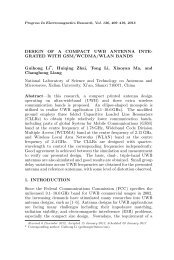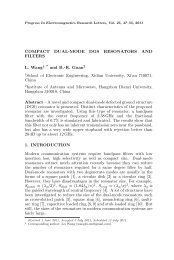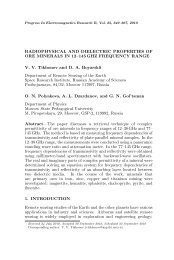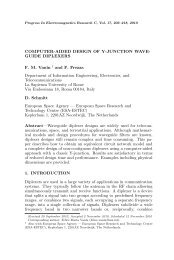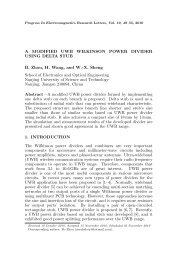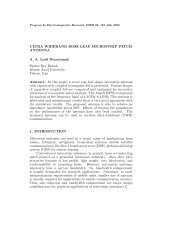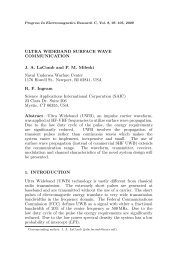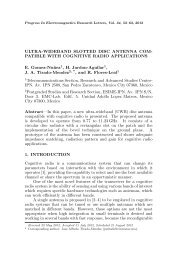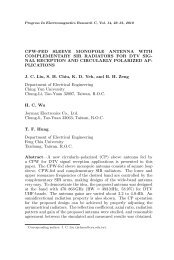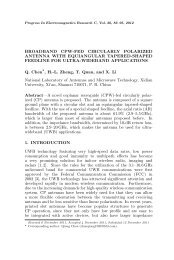UWB-MIMO ANTENNA WITH NOVEL STUB STRUCTURE A ... - PIER
UWB-MIMO ANTENNA WITH NOVEL STUB STRUCTURE A ... - PIER
UWB-MIMO ANTENNA WITH NOVEL STUB STRUCTURE A ... - PIER
Create successful ePaper yourself
Turn your PDF publications into a flip-book with our unique Google optimized e-Paper software.
252 Najam, Duroc, and Tedjni<br />
To further elaborate the effectiveness of the insertion of the stub,<br />
the degree of isolation in the proposed antenna can be observed by<br />
presenting surface current distributions. Fig. 6 shows the current<br />
distributions with and without stub at three frequencies 3.5 GHz,<br />
7 GHz and 9.5 GHz when left radiating element is excited while the<br />
right radiating element is terminated with a load impedance of 50 Ω.<br />
The effects of the stub on the current distributions can clearly be<br />
noticed by comparing with those without stub. The current is<br />
absorbed by stub and thus it ameliorates the port isolation between two<br />
monopoles. In addition to this, it is worth mentioning that the mutual<br />
coupling is also reduced taking advantage of this stub by looking into<br />
these current distributions.<br />
4. PERFORMANCE OF <strong>UWB</strong>-<strong>MIMO</strong> <strong>ANTENNA</strong><br />
4.1. Radiation Characteristics<br />
The designed antenna is placed in XY-plane with Z-axis coming<br />
out of the page (Fig. 1(a)). The radiation patterns of the antenna<br />
are simulated at the frequencies of 3.5, 7.0 and 9.5 GHz in Y OZplane<br />
(E-plane) and XOZ-plane (H-plane). Fig. 7 presents the<br />
radiation patterns of the left radiating element of antenna in the polar<br />
coordinates. The results show that antenna behaves nearly omnidirectional<br />
in H-plane. The humps and notches are observed in Eplane<br />
due to uneven and complex distributions of the current.<br />
Figure 8 gives the plots of maximum absolute gains and the total<br />
efficiencies of the proposed antenna compared to the antenna without<br />
stub. Looking into these plots, it can be noticed that gain is being<br />
reduced by an average of about 1 dBi when the stub is inserted. <strong>UWB</strong><br />
(a) (b)<br />
Figure 8. Simulated (a) absolute gains and (b) total efficiencies of<br />
the proposed antenna.





